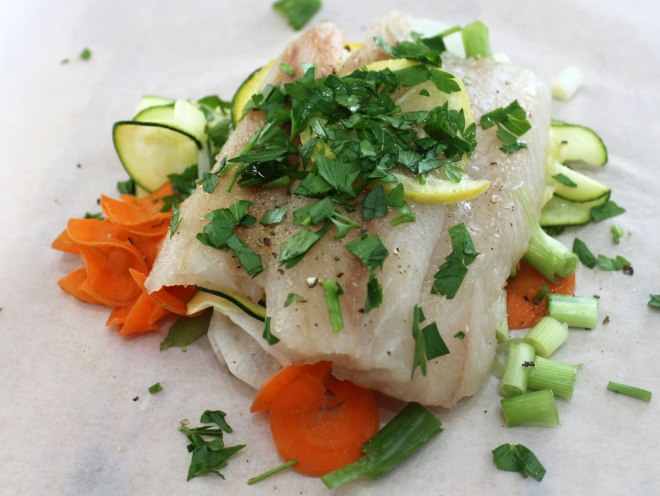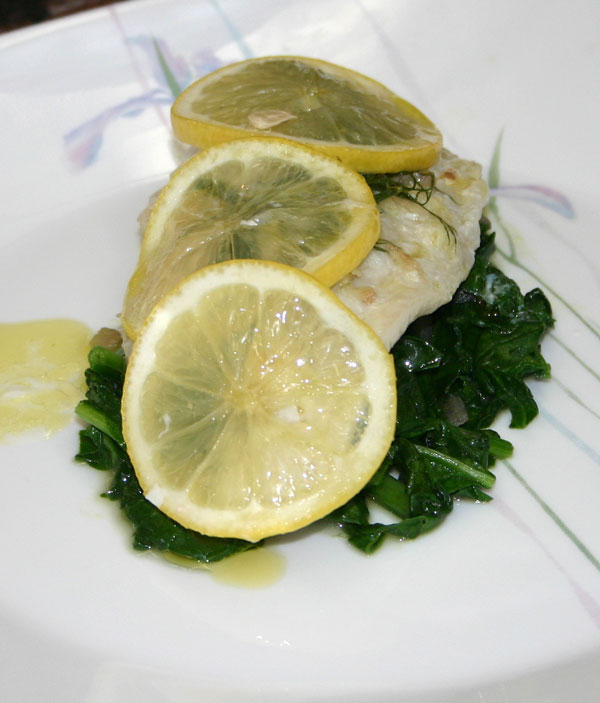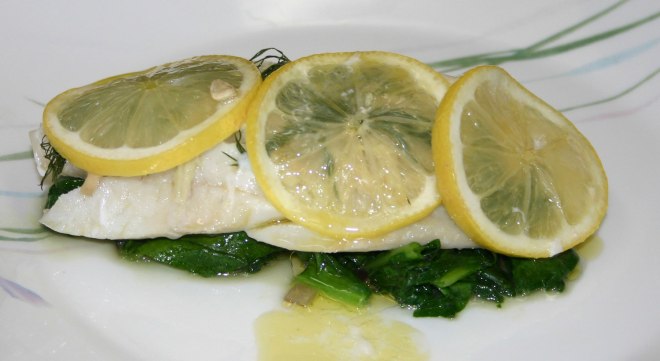Cooking fish in parchment paper results in moist, tender, flakey fish.
It takes a bit of advance preparation, and can be a little fiddley the first time you do it, but the results are SO worth it. The parchment protects the delicate fish from the heat of the oven, and the vegetables, herbs and lemon provide so much flavour.
I find it so easy to overcook fish, but this method is almost foolproof.
This is my favourite way to cook all kinds of fish, not just cod. Try it with salmon or sole – it will be beautiful.
I chose to use cod for this dish. Cod is always wild caught, and as long as you avoid North Sea cod, is not an endangered species. Please do not eat North Sea cod – it has been very over-fished in the last few years and the fish-stock is threatened. But Pacific cod and North Atlantic cod are thriving. I am not too worried about the radiation in the pacific from Fukishima – see this post for the reasons why.
This recipe does contain a little white wine, but the alcohol will evaporate during the cooking leaving only the flavour. If this is still a concern for you, replace the wine with bone broth (preferably a fish bone broth) or some lemon juice.
The black pepper makes this a stage 1 reintroduction recipe. This can easily be omitted to make this recipe strict AIP compliant. When reintroducing foods on the AIP, I recommend this guide.
This recipe is easy to scale down for just one or two people… simply reduce the quantities you make. I made this for 6 people because there are 6 people in our family.
Parchment Baked Cod
serves 6

- 6 fillets of wild-caught cod
- 3 zucchini
- 3 carrots – peeled
- 2 onions
- 1 bunch of green onions
- 3 lemons
- 1 handful of Italian parsley
- sea salt and freshly ground black pepper to taste (omit the pepper if sensitive to it or strict AIP)
- white wine to moisten (optional – if strict AIP replace with bone broth (preferably fish bone broth) or lemon juice)
- Avocado or olive oil to drizzle
The first thing you need to do is to preheat your oven to 190°/375°F.
Next you cut 6 pieces of parchment paper – you want squares around 12-14 inches on each side.
Take the zucchini and use a spiral cutter to cut them in to thick spiral shapes. If you do not own a spiral cutter, you could grate them or cut them into thin julienne shreds.
Peel the carrots and treat them in the same way as the zucchini – either spiral slice them, grate them or julienne them.
Trim the root end from the green onions and chop into small pieces.
Peel the onions and slice as thinly as you can.
Slice the lemons into thin slices.
Chop the parsley.
If the fish fillets are long, you may need to cut them in half. Use your judgment. They need to be a suitable size to fit in the parchment paper parcel. If they are too big, cut them in half.
Pile the veggies on the parchment paper sheets, dividing them evenly.
Top the veggies with the lemon slices, reserving one slice to lay on top of the fish fillets.
Now sit the fish on top of all the veggies. Lay a lemon slice on top of the fish, scatter with the parsley and season well with salt and pepper.

Pour a splash of white wine (if using ) over the fish – no more than 1 tbsp per parcel. If you do not use wine, substitute fish bone broth or lemon juice. Drizzle the fish with a little olive oil or avocado oil.
Fold the parchment in half so that opposite corners meet then start to roll the edges, twisting the corners and tucking them under to make a neat parcel.

Place the finished parcels on a baking sheet and then bake in the oven for 15-20 minutes until the fish is opaque and tender.

I recommend that you check one packet after 15 minutes and if it is not cooked, reseal and continue cooking.
Allow the fish to rest for 5 minutes then serve.

The diner opens their packet at the table releasing a delicious aroma.
I like to serve these with oven-baked vegetable fries. No extra veggies are needed.
Shared at Paleo AIP Recipe Roundup #29
Shared at Gluten-free and DIY Tuesdays




























